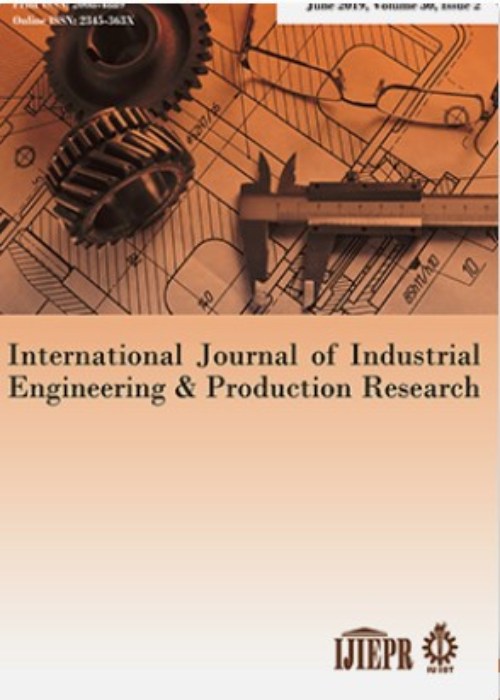فهرست مطالب
International Journal of Industrial Engineering and Productional Research
Volume:19 Issue: 1, Mar 2008
- تاریخ انتشار: 1378/10/01
- تعداد عناوین: 5
-
-
Page 29Stochastic models such as mixture models, graphical models, Markov random fields and hidden Markov models have key role in probabilistic data analysis. In this paper, we used Gaussian mixture model to the pixels of an image. The parameters of the model were estimated by EM-algorithm. In addition pixel labeling corresponded to each pixel of true image was made by Bayes rule. In fact, a new numerically method was introduced for finding the maximum a posterior estimation by using EM-algorithm and Gaussians mixture distribution. In this algorithm, we were made a sequence of priors, posteriors were made and then converged to a posterior probability that is called the reference posterior probability. Maximum a posterior estimated can determine by the reference posterior probability which can make labeled image. This labeled image shows our segmented image with reduced noises. We presented this method in several experiments.
-
Page 33A tandem automated guided vehicle (AGV) system deals with grouping workstations into some non-overlapping zones, and assigning exactly one AGV to each zone. This paper presents a new non-linear integer mathematical model to group n machines into N loops that minimizes both inter and intra-loop flows simultaneously. Due to computational difficulties of exact methods in solving our proposed model, a threshold accepting (TA) algorithm is proposed. To show its efficiency, a number of instances generated randomly are solved by this proposed TA and then compared with the LINGO solver package employing the branch-and-bound (B/B) method. The related computational results show that our proposed TA dominates the exact algorithm when the size of instances grows.
-
Page 43Innovations, commercialized by new or old established firms, located at the core of industrial renewal process. The innovation concept has suffered transformations, along with the evolution of the models that try to explain and understand the innovation process. The innovative process corresponds to all activities that generate technological changes and the dynamic interaction between them, not necessarily being novelties. Linier model, Chain-Linked Model and National Innovation Systems (NIS) Approach, are three models that have developed for innovation process. Innovation process can be viewed as evolutionary process. One can recognize some mechanism for innovation evolution. These are grouped into two classes; those that increase configurations variation and those that decrease it. Emergence of knowledge, knowledge flow and recombination are the mechanism to increase variation of configuration. Internal and external selections are the mechanism to selecting. Innovation operators are evolutionary operators that create new combinations of configuration and increase variation. This paper develops an evolutionary cycle in innovation process and extends evolutionary mechanisms of innovation.
-
Page 57At the last decade of the 20th century, Womack et. Al introduced Lean concept to the industrial world. Since 1990 up to now, existed studies mostly have focused on lean production in the step of manufacturing, but in this research leanness concept has developed in the plant life cycle. In this paper leanness concept will be described as elimination of wastes in the phases of investment, plant design & construction(hardware), organization & systems design (software) and these three steps will be added to, elimination of previously described seven wastes in production step. For this purpose at first, the types of wastes in the above mentioned phases are defined by using Axiomatic Design methodology. After defining the types of wastes, a model for assessment of leanness is submitted. In this quantitative model, amount of leanness in each phase will be determined and combined to make a unique measure for total leanness. Dimensions of leanness are shown for quick understanding, by using a spider diagram. In the last section of the paper, the results of an example of the application of this model in fan industry are brought. This example shows the simplicity and powerfully of the model to determine the leanness in before production phases. © 2008 Authors all rights reserved.
-
Page 67Bi-level programming, a tool for modeling decentralized decisions, consists of the objective(s) of the leader at its first level and that is of the follower at the second level. Three level programming results when second level is itself a bi-level programming. By extending this idea it is possible to define multi-level programs with any number of levels. Supply chain planning problems are concerned with synchronizing and optimizing multiple activities involved in the enterprise, from the start of the process, such as procurement of the raw materials, through a series of process operations, to the end, such as distribution of the final product to customers. Enterprise-wide supply chain planning problems naturally exhibit a multi-level decision network structure, where for example, one level may correspond to a local plant control/scheduling/planning problem and another level to a corresponding plant-wide planning/network problem. Such a multi-level decision network structure can be mathematically represented by using “multi-level programming” principles. This paper studies a “bi-level linear multi-objective decision making” model in with “interval” parameters and presents a solution method for solving it; this method uses the concepts of tolerance membership function and multi-objective multi-level optimization when all parameters are imprecise and interval.


